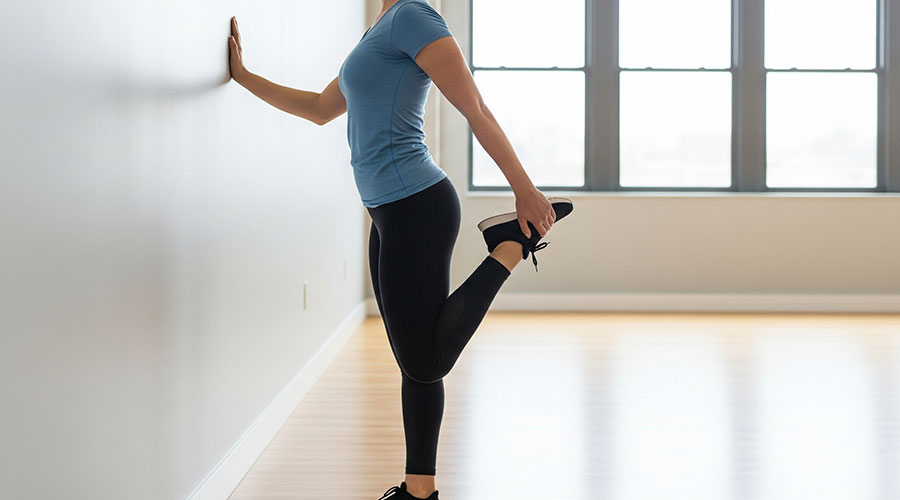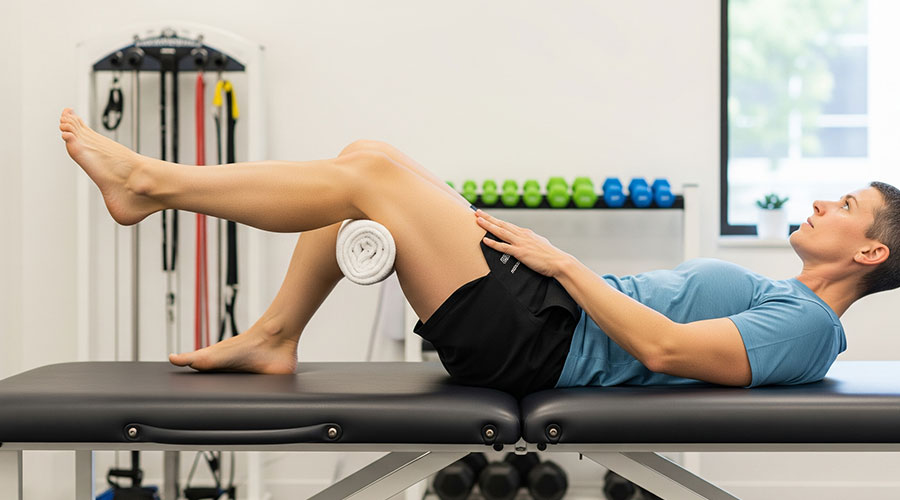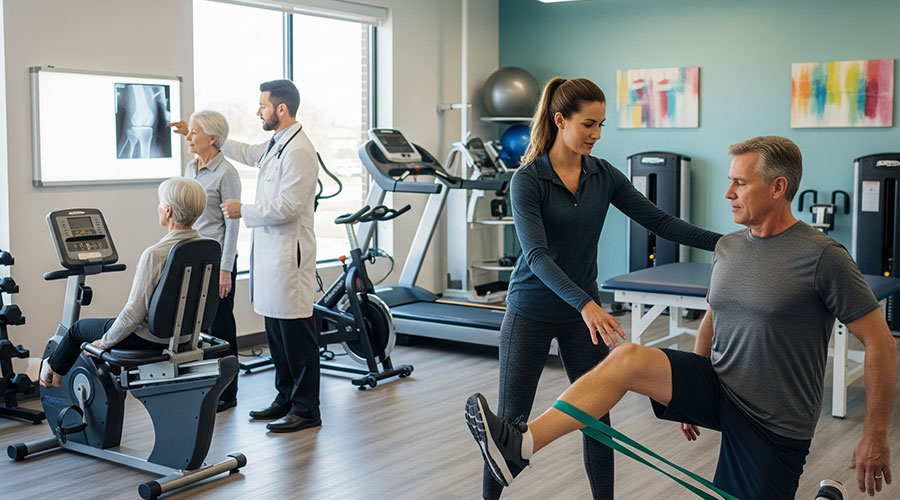Knee pain is one of the most common physical complaints, affecting nearly half of adults over 50 and a surprising 30% of younger individuals. It can turn simple daily activities like walking, climbing stairs, or even standing into a painful ordeal.
While it may seem counterintuitive, gentle movement is often better for a painful knee than keeping it still. A structured exercise program focused on low-impact stretching and strengthening can significantly relieve pain, improve flexibility and range of motion, and build up the muscles that support and protect the knee joint.
❗️ Important Safety Warning: Always consult with a licensed physical therapist before starting any new exercise program, and be sure to review these key questions to ask your therapist to get the most out of your consultation.
Key Principles Before You Begin
To get the most out of these exercises safely, keep these general principles in mind:
- Warm-Up First: Always begin with 5 to 10 minutes of light, low-impact activity to get your blood flowing. A stationary bike, elliptical machine, or a brisk walk are excellent choices.
- Proper Timing: Perform stretching exercises both before and after your strengthening routine to maximize flexibility.
- Be Consistent: Aim to perform this routine at least 4-5 times per week for the best results. For maintenance, 2-3 times per week is sufficient.
- Target the Right Muscles: A stable knee relies on a strong support system. Our general physiotherapy exercises guide covers many of these foundational movements.
Lower-Body Stretches for Knee Pain

These gentle stretches are designed to improve your joint’s range of motion and increase flexibility, which can help alleviate stiffness and pain.
1. Heel and Calf Stretch
This stretch targets the calf muscles, which can pull on the knee if they are too tight.
- Instructions: Stand facing a wall. Place your hands on the wall and step one foot back, keeping the leg straight. Keep your back heel on the floor. Gently lean forward until you feel a stretch in the calf of your back leg.
- Hold: 30 seconds. Repeat 2 times for each leg.
2. Quadriceps Stretch
Stretching the quads can relieve pressure on the front of the knee.
- Instructions: Stand next to a wall or chair for balance. Bend one knee, bringing your heel up towards your glute. Grasp your ankle and gently pull until you feel a stretch in the front of your thigh.
- Hold: 30-60 seconds. Repeat 2 times for each leg.
3. Hamstring Stretch (Lying Down)
Tight hamstrings can affect posture and add stress to the knee joint.
- Instructions: Lie on your back with both knees bent. Lift one leg up, keeping it as straight as possible. You can loop a towel around your foot and gently pull the leg towards you until you feel a stretch in the back of your thigh.
- Hold: 30 seconds. Repeat 2 times for each leg.
Strengthening Exercises for Knee Pain

Building strength in the muscles surrounding the knee is crucial for absorbing shock and reducing stress on the joint itself.
4. Half Squat (Mini Squat)
This is a safer version of a full squat that strengthens your quads and glutes without over-stressing the knees.
- Instructions: Stand with your feet shoulder-width apart. Slowly bend your knees as if you are about to sit in a chair, lowering yourself about 6 inches (15 cm). Keep your back straight and ensure your knees don't go past your toes.
- Reps: 2-3 sets of 10 repetitions.
5. Calf Raises
Strong calves help with balance and support the lower leg.
- Instructions: Stand with your feet flat on the floor, using a chair or wall for balance. Slowly lift your heels off the ground, rising onto your toes. Hold briefly, then slowly lower your heels back down.
- Reps: 2-3 sets of 10-12 repetitions.
6. Hamstring Curl
This exercise targets the muscles on the back of your thigh.
- Instructions: Stand and hold onto the back of a chair. Slowly bend one knee and lift your heel towards the ceiling as far as you can without discomfort.
- Reps: 2-3 sets of 10-12 repetitions for each leg. Pro Tip: Add a light ankle weight to increase the challenge.
7. Straight Leg Raises
This strengthens the quadriceps without putting any weight through the knee joint.
- Instructions: Lie on your back with one leg straight and the other knee bent with your foot flat on the floor. Tighten your thigh muscle (quad) on the straight leg and slowly lift it about 12 inches (30 cm) off the floor. Hold briefly and lower slowly.
- Reps: 2-3 sets of 10-15 repetitions for each leg.
8. Side Leg Raises (Hip Abduction)
Strengthening the outer hip muscles (abductors) is critical for knee stability and preventing pain.
- Instructions: Lie on your side with your legs stacked. Keeping your leg straight, slowly lift your top leg towards the ceiling. Don't rotate your hip. Lower it back down with control.
- Reps: 2-3 sets of 15-20 repetitions for each leg.
9. Prone Leg Raises
This exercise targets your hamstrings and glutes.
- Instructions: Lie on your stomach with your legs straight. Tighten the glute and hamstring muscles of one leg and lift it towards the ceiling.
- Reps: 2-3 sets of 10-12 repetitions for each leg.
10. Bridging
The bridge strengthens your glutes and hamstrings, which are key supporters of the knee.
- Instructions: Lie on your back with your knees bent, feet flat on the floor hip-width apart. Squeeze your glutes and lift your hips off the floor until your body forms a straight line from your shoulders to your knees. Hold, then lower.
- Reps: 10-15 repetitions for 2-3 sets.
Maintaining proper alignment is vital, as weakness in the glutes or hips (which impact the knee) can often lead to compensatory issues in the lower back and even cause distant problems like Neck Pain. A comprehensive assessment always considers the body as a whole.
Other Beneficial Low-Impact Exercises
Once your knee feels stronger, incorporating other low-impact activities into your routine is a great way to maintain joint health without causing stress. Consider:
- Swimming or Water Aerobics
- Stationary Cycling
- Yoga or Tai Chi
- Walking on flat, even surfaces
A Comprehensive Approach to Knee Pain

In addition to home exercises, a physical therapist may recommend a holistic treatment plan that includes:
- Ice Application: To reduce pain and inflammation after activity.
- Specialized Techniques: A therapist may use methods like dry needling to target trigger points and release muscle tension
- Medication: Short-term use of over-the-counter NSAIDs (like ibuprofen), either oral or topical, may be suggested in the first few days after an injury.
- Compression Therapy: Using a simple brace or advanced Therabody Compression systems can help reduce swelling and provide stability
Research shows that supervised physiotherapy often yields better results in reducing knee pain than home exercises alone. Seeking a professional can provide you with a tailored plan for faster, safer recovery.
Conclusion: Move Towards a Healthier Knee
Consistently performing these stretching and strengthening exercises can significantly relieve pain, improve your range of motion, increase flexibility, and reduce your risk of future injuries.
Remember, the most crucial step is the first one: consulting with your doctor or physical therapist. They can provide a proper diagnosis and create a personalized exercise plan that is safe and effective for your specific condition and the underlying cause of your knee pain.



